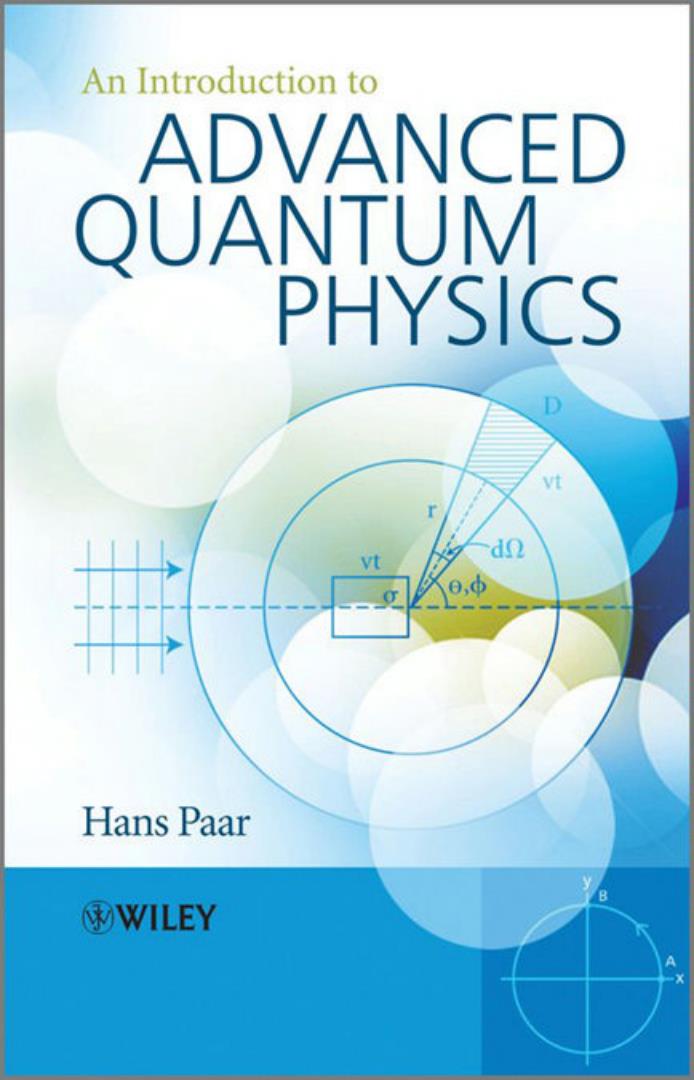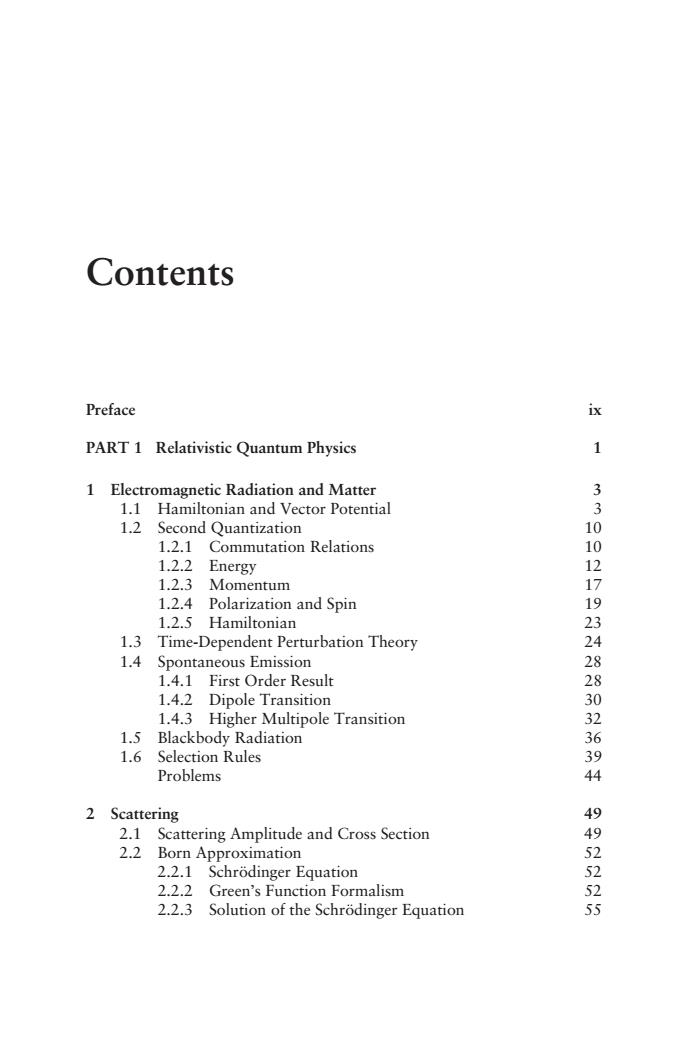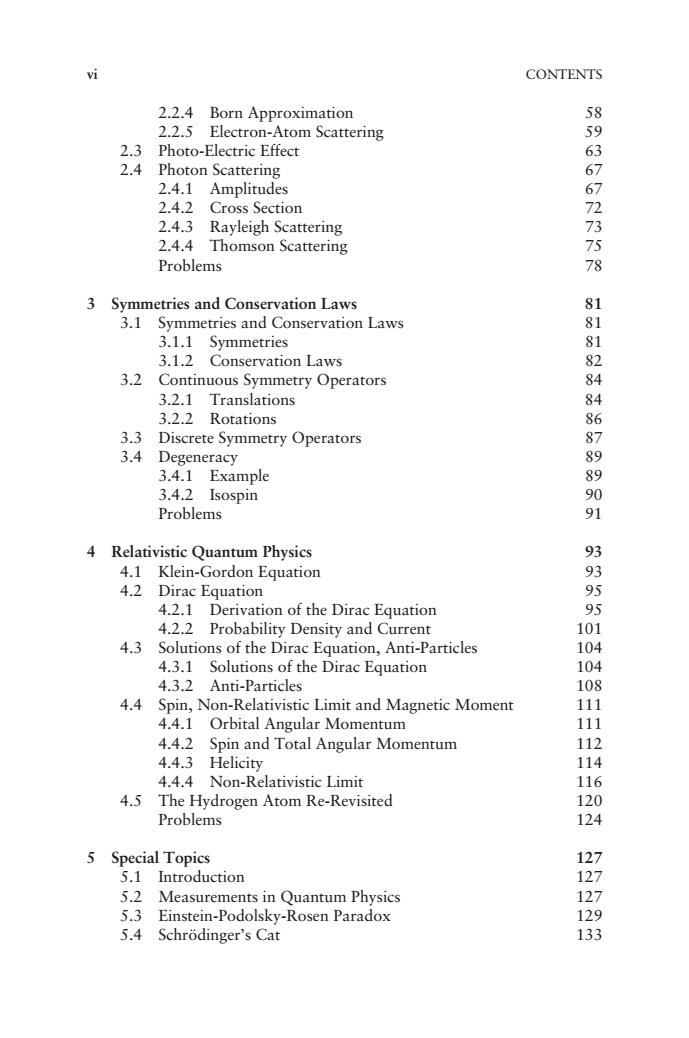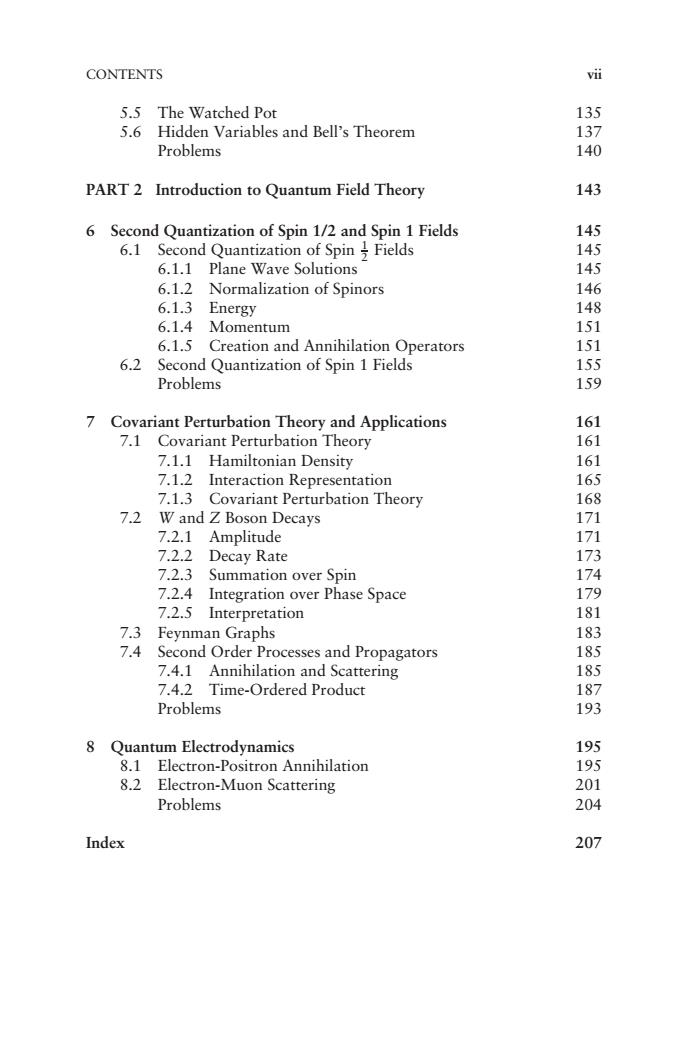
An Introduction to ADVANCED QUANTUM PHYSICS d0 Hans Paar WWILEY

Registered office John Wiley Sons Ltd,The Atrium,Southern Gate,Chichester,West Sussex,PO1985Q.United For details of our global editorial offices,for customer services and for information about how to apply for permission to reuse the copyright material in this book please see our website at www.wiley.com. permission of the publisher. that appears in print may Designations used by companies to disting guish their products are often claimed as trademarks.All are t otheubictmatercorcrcd上isol the und ling that the pu sher is The publisher and the author with resp limitation any implied warranties of fimess for a particular purpose.This work is sold with the understanding that the publisher is not engag in rendering professional services.The advice and and h valuate the information provided in the packag insertorinstructiost in this work as a citation andor a potential source of further information does not mean that the array have changed or disappeared between when this work was wrien and when read.No Library of Congress Cataloging-in-Publication Data duction to advanced quantum physics /Hans P.Paar. m-470-675-1 () -Textbooks.L Title 2009054392 A catalogue record for this book is available from the British Library. I5BN:Hbk978-0470-68676-8P6k978-0-470-68675-】 Typeset in 10/12 Sabon by Lase erwvords Private limited Chennai India Printed and bound in Great Britain by T]Intemational,Padstow,Cornwall
This edition first published 2010 2010 John Wiley and Sons, Ltd. Registered office John Wiley & Sons Ltd, The Atrium, Southern Gate, Chichester, West Sussex, PO19 8SQ, United Kingdom For details of our global editorial offices, for customer services and for information about how to apply for permission to reuse the copyright material in this book please see our website at www.wiley.com. The right of the author to be identified as the author of this work has been asserted in accordance with the Copyright, Designs and Patents Act 1988. All rights reserved. No part of this publication may be reproduced, stored in a retrieval system, or transmitted, in any form or by any means, electronic, mechanical, photocopying, recording or otherwise, except as permitted by the UK Copyright, Designs and Patents Act 1988, without the prior permission of the publisher. Wiley also publishes its books in a variety of electronic formats. Some content that appears in print may not be available in electronic books. Designations used by companies to distinguish their products are often claimed as trademarks. All brand names and product names used in this book are trade names, service marks, trademarks or registered trademarks of their respective owners. The publisher is not associated with any product or vendor mentioned in this book. This publication is designed to provide accurate and authoritative information in regard to the subject matter covered. It is sold on the understanding that the publisher is not engaged in rendering professional services. If professional advice or other expert assistance is required, the services of a competent professional should be sought. The publisher and the author make no representations or warranties with respect to the accuracy or completeness of the contents of this work and specifically disclaim all warranties, including without limitation any implied warranties of fitness for a particular purpose. This work is sold with the understanding that the publisher is not engaged in rendering professional services. The advice and strategies contained herein may not be suitable for every situation. In view of ongoing research, equipment modifications, changes in governmental regulations, and the constant flow of information relating to the use of experimental reagents, equipment, and devices, the reader is urged to review and evaluate the information provided in the package insert or instructions for each chemical, piece of equipment, reagent, or device for, among other things, any changes in the instructions or indication of usage and for added warnings and precautions. The fact that an organization or Website is referred to in this work as a citation and/or a potential source of further information does not mean that the author or the publisher endorses the information the organization or Website may provide or recommendations it may make. Further, readers should be aware that Internet Websites listed in this work may have changed or disappeared between when this work was written and when it is read. No warranty may be created or extended by any promotional statements for this work. Neither the publisher nor the author shall be liable for any damages arising herefrom. Library of Congress Cataloging-in-Publication Data Paar, Hans P. An introduction to advanced quantum physics / Hans P. Paar. p. cm. Includes bibliographical references and index. ISBN 978-0-470-68676-8 (cloth) – ISBN 978-0-470-68675-1 (pbk.) 1. Quantum theory – Textbooks. I. Title. QC174.12P33 2010 530.12 – dc22 2009054392 A catalogue record for this book is available from the British Library. ISBN: H/bk 978-0-470-68676-8 P/bk 978-0-470-68675-1 Typeset in 10/12 Sabon by Laserwords Private Limited, Chennai, India Printed and bound in Great Britain by TJ International, Padstow, Cornwall

Contents Preface PART 1 Relativistic Quantum Physics 1 Electromagnetic Radiation and Matter 1.1 Hamiltonian and Vector Potential 1.2 Second Quantization 10 1.2.1 Commutation Relations 1.2) Energy 1.2. Momentum 127 1.2.4 Polarization and Spin 1.2.5 Hamiltonian 3 1.3 Time-Dependent Perturbation Theory 1.4 28 14.1 irst Order R 1.4. Dipole Tra 1.4.3 Higher Multipole Transition 1.5 Blackbody Radiation 36 1.6 Selection Rules Problems 2 Scattering 2.1 Scattering Amplitude and Cross Section 99 2.2 Born Approximation 2.2.1 Schrodinger Equation 2.2.2 Green's Function Formalism 52 2.2.3 Solution of the Schrodinger Equation 55
Contents Preface ix PART 1 Relativistic Quantum Physics 1 1 Electromagnetic Radiation and Matter 3 1.1 Hamiltonian and Vector Potential 3 1.2 Second Quantization 10 1.2.1 Commutation Relations 10 1.2.2 Energy 12 1.2.3 Momentum 17 1.2.4 Polarization and Spin 19 1.2.5 Hamiltonian 23 1.3 Time-Dependent Perturbation Theory 24 1.4 Spontaneous Emission 28 1.4.1 First Order Result 28 1.4.2 Dipole Transition 30 1.4.3 Higher Multipole Transition 32 1.5 Blackbody Radiation 36 1.6 Selection Rules 39 Problems 44 2 Scattering 49 2.1 Scattering Amplitude and Cross Section 49 2.2 Born Approximation 52 2.2.1 Schrodinger Equation ¨ 52 2.2.2 Green’s Function Formalism 52 2.2.3 Solution of the Schrodinger Equation ¨ 55

vi CONTENTS 2.2.4 Born Approximation 58 2.2.5 Electron-Atom Scattering 59 2.3 Photo-Electric Effect 2.4 Photon Scattering 61 2.4.1 Amplitudes 7 2.4.2 Cross Section 72 2.4.3 Rayleigh Scattering 2.4.4 Thomson Scattering 7 Problems 3 Symmetries and Conservation Laws 81 3.1 Symmetries and Conservation Laws 3.1.1 Symmetries 88 3.1.2 Conservation Laws 82 3.2 Continuous Symmetry Operators 84 3.2.1 Translations 84 3.2.2 Rotations 3.3 Discrete Symmetry Operators 83 3.4 Degeneracy 8 3.4.1 Example 3.4.2 Isospin 0 Problems 4 Relativistic Quantum Physics 93 4.1 Klein-Gordon Equation 93 4.2 Dirac Equation 4.2.1 Derivation of the Dirac Equation 4.2.2 Probability Density and Current 101 4.3 Solutions of the Dirac Equation,Anti-Particles 104 4.3.1 Solutions of the Dirac Equation 104 4.3.2 Anti-Particles 108 4.4 Spin,Non-Relativistic Limit and Magnetic Moment 111 4.4.1 Orbital Angular Momentum 111 4.4.2 Spin and Total Angular Momentum 112 4.4.3 Helicity 114 4.4.4 Non-Relativistic Limit 116 4.5 The Hydrogen Atom Re-Revisited 120 Problems 124 5 Special Topics 127 5.1 Introduction 127 5.2 Measurements in Quantum Physics 127 5.3 Einstein-Podolsky-Rosen Paradox 129 5.4 Schrodinger's Cat 133
vi CONTENTS 2.2.4 Born Approximation 58 2.2.5 Electron-Atom Scattering 59 2.3 Photo-Electric Effect 63 2.4 Photon Scattering 67 2.4.1 Amplitudes 67 2.4.2 Cross Section 72 2.4.3 Rayleigh Scattering 73 2.4.4 Thomson Scattering 75 Problems 78 3 Symmetries and Conservation Laws 81 3.1 Symmetries and Conservation Laws 81 3.1.1 Symmetries 81 3.1.2 Conservation Laws 82 3.2 Continuous Symmetry Operators 84 3.2.1 Translations 84 3.2.2 Rotations 86 3.3 Discrete Symmetry Operators 87 3.4 Degeneracy 89 3.4.1 Example 89 3.4.2 Isospin 90 Problems 91 4 Relativistic Quantum Physics 93 4.1 Klein-Gordon Equation 93 4.2 Dirac Equation 95 4.2.1 Derivation of the Dirac Equation 95 4.2.2 Probability Density and Current 101 4.3 Solutions of the Dirac Equation, Anti-Particles 104 4.3.1 Solutions of the Dirac Equation 104 4.3.2 Anti-Particles 108 4.4 Spin, Non-Relativistic Limit and Magnetic Moment 111 4.4.1 Orbital Angular Momentum 111 4.4.2 Spin and Total Angular Momentum 112 4.4.3 Helicity 114 4.4.4 Non-Relativistic Limit 116 4.5 The Hydrogen Atom Re-Revisited 120 Problems 124 5 Special Topics 127 5.1 Introduction 127 5.2 Measurements in Quantum Physics 127 5.3 Einstein-Podolsky-Rosen Paradox 129 5.4 Schrodinger’s Cat ¨ 133

CONTENTS vii 5.5 The Watched Pot 135 5.6 Hidden Variables and Bell's Theorem 137 Problems 140 PART 2 Introduction to Quantum Field Theory 143 6 Second Quantization of Spin 1/2 and Spin 1 Fields 145 6.1 Second Quantization of Spin Fields 145 6.1.1 Plane Wave Solutions 145 6.1.2 Normalization of Spinors 146 6.1.3 Energy 148 6.1.4 Momentum 151 6.1.5 Creation and Annihilation Operators 151 6.2 Second Quantization of Spin 1 Fields 155 Problems 159 7 Covariant Perturbation Theory and Applications 161 7.1 Covariant Perturbation Theory 161 7.1.1 Hamiltonian Density 161 7.1.2 Interaction Representation 165 7.1.3 Covariant Perturbation Theory 168 7.2 W and Z Boson Decays 171 7.2.1 Amplitude 171 7.2.2 Decay Rate 173 7.2.3 Summation over Spin 174 7.2.4 Integration over Phase Space 179 7.2.5 Interpretation 181 7.3 Feynman Graphs 183 7.4 Second Order Processes and Propagators 185 7.4.1 Annihilation and Scattering 185 7.4.2 Time-Ordered Product 187 Problems 193 8 Quantum Electrodynamics 195 8.1 Electron-Positron Annihilation 195 8.2 Electron-Muon Scattering 201 Problems 204 Index 207
CONTENTS vii 5.5 The Watched Pot 135 5.6 Hidden Variables and Bell’s Theorem 137 Problems 140 PART 2 Introduction to Quantum Field Theory 143 6 Second Quantization of Spin 1/2 and Spin 1 Fields 145 6.1 Second Quantization of Spin 1 2 Fields 145 6.1.1 Plane Wave Solutions 145 6.1.2 Normalization of Spinors 146 6.1.3 Energy 148 6.1.4 Momentum 151 6.1.5 Creation and Annihilation Operators 151 6.2 Second Quantization of Spin 1 Fields 155 Problems 159 7 Covariant Perturbation Theory and Applications 161 7.1 Covariant Perturbation Theory 161 7.1.1 Hamiltonian Density 161 7.1.2 Interaction Representation 165 7.1.3 Covariant Perturbation Theory 168 7.2 W and Z Boson Decays 171 7.2.1 Amplitude 171 7.2.2 Decay Rate 173 7.2.3 Summation over Spin 174 7.2.4 Integration over Phase Space 179 7.2.5 Interpretation 181 7.3 Feynman Graphs 183 7.4 Second Order Processes and Propagators 185 7.4.1 Annihilation and Scattering 185 7.4.2 Time-Ordered Product 187 Problems 193 8 Quantum Electrodynamics 195 8.1 Electron-Positron Annihilation 195 8.2 Electron-Muon Scattering 201 Problems 204 Index 207